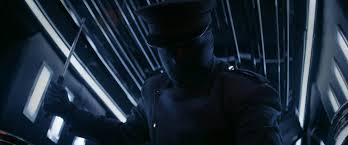Some kind of religious revival seems to be going on outside Frightfest’s new (old) home, the Cineworld (formerly Empire) Leicester Square. A sign saying ‘Repent or Perish’ has been held aloft. I wonder if this is particularly aimed at the Frightfest crowd. Maybe it’s just a promotion for the latest Saw film.
I’m not a fan of those films (not that I’ve seen many). That Jigsaw (or whoever the villain is now) reminds me of a precocious (and psychopathic) child playing a ‘let’s pretend’ game where he is always granting himself the upper hand, however ludicrous the situation becomes. (Victim: ‘I’m free!’ Jigsaw: ‘AH, but I’ve injected you with a slow-acting poison that will make your heart explode unless you disembowel yourself with this rusty spoon in the next 10 seconds.’ This isn’t frightening, it’s just bloody irritating.)
In the Q&A following Spanish film The Glass Coffin I mistook an audience member’s question about mysterious ‘sores’ that appearing on the heroine’s body as a reference to the Saw franchise, and it was almost as if somebody had named the elephant in the room.
The Glass Coffin does indeed begin with a Saw-style situation but moves on from that. Which may be it’s mistake. It starts off rather well, with Amanda, an actress climbing into a stretch limo to attend an awards ceremony, only to discover, as the windows darken and a distorted voice starts threatening her, that the trappings of success have become a trap.
It’s a good idea. (For a film, I mean.) The setting, already exploited in David Cronenberg’s unsatisfying Cosmopolis is effectively claustrophobic, replete with a kind of inhuman luxury, and Paola Bontempi plays the transition between initial complacency and growing unease very well. There’s also a wittily self-reflexive air around Amanda’s plight, since her sufferings are being filmed and she thus becomes the ‘heroine’ of a much less worthy film than she is used to starring in.
This trend is further elaborated by the revelation that her tormentor, who turns out to be female rather than male as we originally thought, is an actress who was up for the part that ‘broke’ Amanda (the autistic heroine of a film called Dry Land of Fireflies) – the loss of this part broke her in another sense, leading her (as she saw it) into a world of pornography, addiction and abuse. And this is her revenge.
If that doesn’t seem quite enough to account for all this, there’s also a metaphysical twist. When we finally see the psycho, she turns out to look like she’s had rather more than a rough time of it over the last few years. Indeed, she seems barely human – an apparition, or even an alien.
It seems that from its fairly straightforward premise, the film has taken a turn for what the director Haritz Zubillaga calls the ‘oneiric’: the identities of the actresses who were up for the same part have become mysteriously twinned, with Amanda’s deformed rival representing all the unpleasantness that the image of the successful actress has to conceal. When only one woman escapes from the final reckoning, it seems to be Amanda initially but there’s a suggestion as she stumbles brokenly away into the night that either they have changed places, or that both women have merged into a single entity.
The problem is that the film hasn’t managed to negotiate that tricky shift from the mundane to the fantastical. It needed to be more boldly surreal maybe. Or subtler. It doesn’t help that the tribulations visited upon Amanda are depressingly unimaginative – rape, a couple of beatings – one area where the Saw franchise might have scored more highly. Although there is the scene where she has to use a defibrillator on herself, a talking one that issues instructions in a bland mechanical voice, creating something that resembles the self-checkout experience of your nightmares.
But that’s hardly enough to ward off a sense of disappointment. A journey that promised to take us from Saw to Mulholland Drive finally dumps us in an undistinguished side road. But at least Zubillaga didn’t take an easy route.


Recent Comments